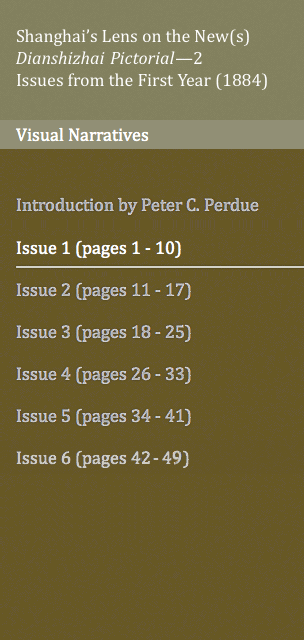| Images: Yale University Library, East Asia LibraryMassachusetts Institute of Technology © 2015 Visualizing Cultures |
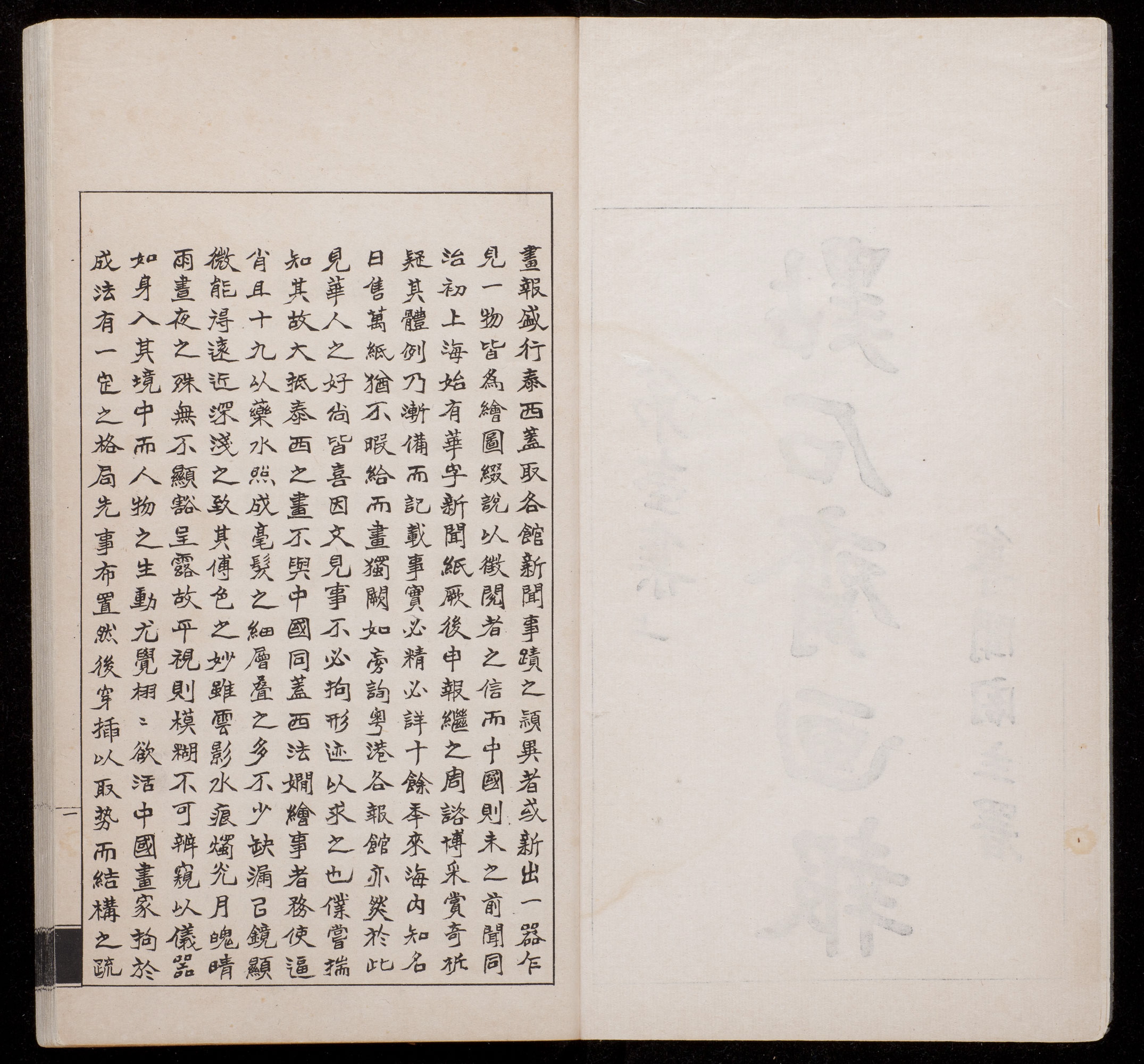 |
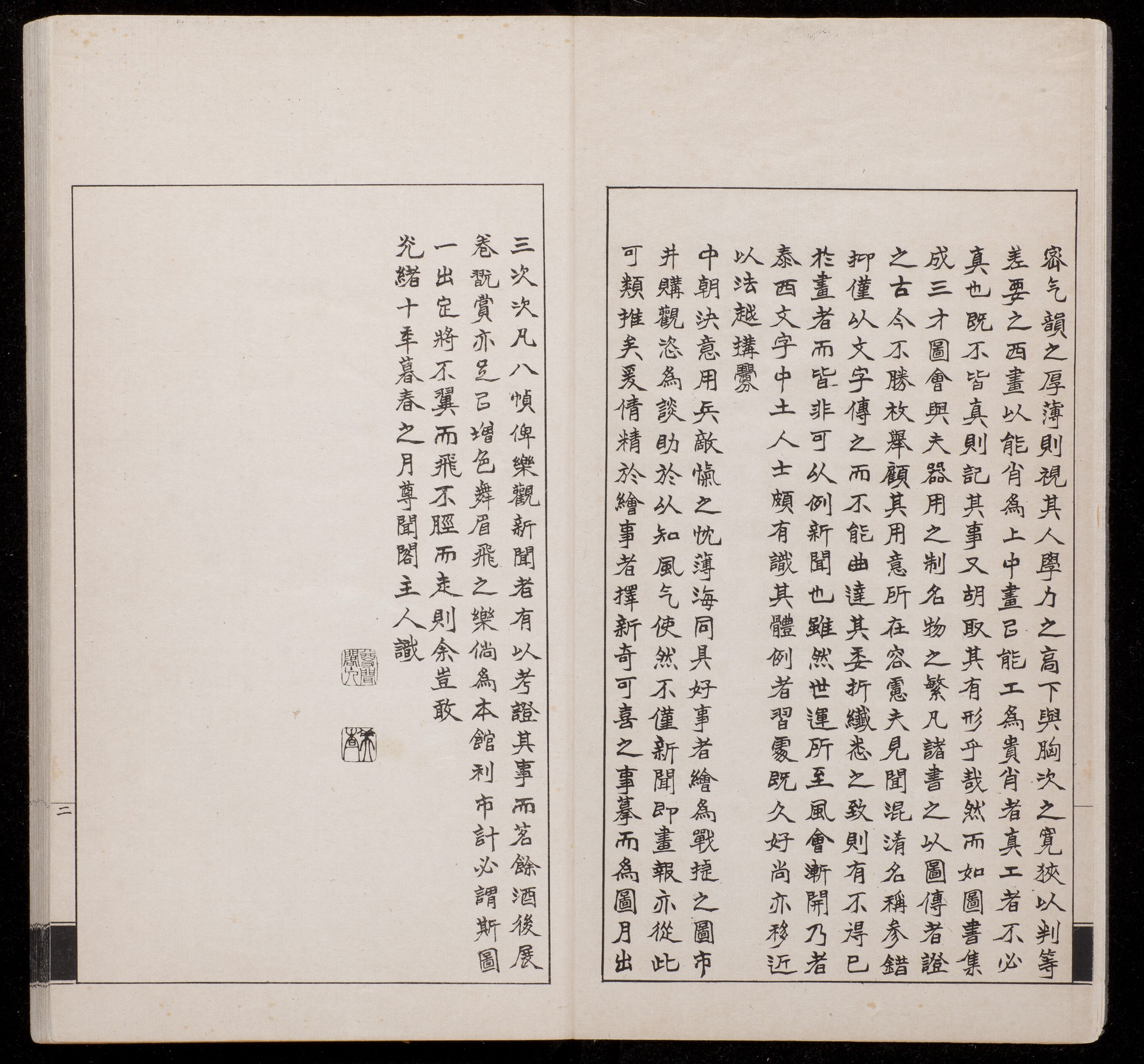 |
Title: Preface Volume: 1 Issue: 1 Page Number: 1, 2 Caption Translation: Illustrated papers are quite popular in the West. They generally select the most unusual items from various newspapers, such as a new device, or a newly sighted thing. They make drawings of them and add explanations In order to convince their readers. China, however, has never had such papers. In the beginning of the Tongzhi era (1862), the first Chinese-language newspaper appeared in Shanghai; then the Shenbao continued it. Now it practices all-enclusive reportage, selecting from a broad range of material, with features of general interest and special attention to curiosities. Its form of presentation has gradually improved, and it presents the facts elegantly and in great detail. During the last decade or so, the Shenbao has become widely known within China, with ten thousand copies sold daily. Still, we had no spare time to provide illustrations. It turned out that the same was true for the Canton and Hong Kong papers. This shows that the Chinese rather enjoy studying the world through texts and do not see the need to explore it in visual form. |
I have endeavored to look into the causes for this. Generally speaking, Western drawing is different from Chinese. Those accomplished in drawing using the Western method [with copper engravings] will strive to get a close likeness. Nearly all of them will use an acid for highlighting, and even in details as fine as the finest hair and with a multitude of different layers [in the perspective], they still leave small spaces [between the lines]. With a magnifying glass one can fully appreciate their achievements in portraying space and depth. Their sophistication in laying on colors is such that minute particulars—shadows of clouds, ripples in the water, the glow of a candle, the dark parts of the moon, clear weather and rain, morning and night—all will be clearly visible. Therefore, if one just glances at [these illustrations], it is hard to make out all the details in the dense texture, but once one looks at them with an instrument [a magnifying glass] then it is as if one was personally entering into the scene, where the people act as if they were all alive. |
The Chinese painter [on the other hand] goes by established rules and has a set style. First of all he sets out the basic structure, and then fills it in to capture the impression. It is in the coherence of the framework and the richness of the atmosphere that one will recognize the [painter's] erudition and the breadth of his inspiration so that one can rank his skill. To sum up, the Western painter will set a premium on his capacity to imitate, while the Chinese painter most highly esteems technique. Imitation must present the truth, while technique need not render the true [features]. But if [painting] is not altogether true to the [original], what is the use of supplementing the [written] report of an event with an illustration? However, [Chinese] works such as the [Gujin] Tushu jicheng and the Sancai Tuhui do show how instruments work and display a variety of renowned artifacts. So there are innumerable examples of illustrated books from ancient and modern times. What is the purpose [of this combination of text and image]? If, faced with a confused melange of information, one relies solely on writing to report it, one will be quite unable to convey it in all its intricacies. In some situations, it is simply impossible to deliver the news without using illustrations. |
However, with the changing times fixed habits gradually alter, so there are now gentlemen from China who have considerable understanding of the form of Western writings. As their familiarity grows with time, their tastes have been transformed. Recently, because the Chinese court has decided to deploy its soldiers in the struggle between France and Vietnam, deep hatred for the enemy has swept through the land. Avid supporters have drawn pictures of victories in this war, which are sold and viewed in the market places, and quite easily become materials for debate, shaping public opinion. We can infer opinion not only from the written news, but also from the illustrated leaflets. I have therefore hired people with fine skills in drawing to illustrate sensational and entertaining scenes. We will publish three issues per month. As a rule each issue will have eight pages, so that those who enjoy the written news can refer to it. But when browsing it for relaxation after drinking tea or wine, [this illustrated paper] will also light up your faces with joy. |
As for the market [for our paper], we may say with confidence that once these drawings are published, they will literally fly off the shelves. What more can I say? Guangxu tenth year in the last month of spring [May 1884] communicated by the Master of the "Appreciate News Studio" (i.e. Ernest Major). Seal 1: Master of the Appreciate News Studio Seal 2: Meicha [Major] Translator: Rudolf Wagner, revised by Peter C. Perdue Comments: This translation is based on Rudolf G. Wagner, Joining the Global Public: Word, Image, and City in Early Chinese Newspapers, 1870-1910 (Albany, N.Y.: State University of New York Press, 2007), pp. 132-134. View on Yale Visual Resources [p01] View on Yale Visual Resources [p02] |
 |
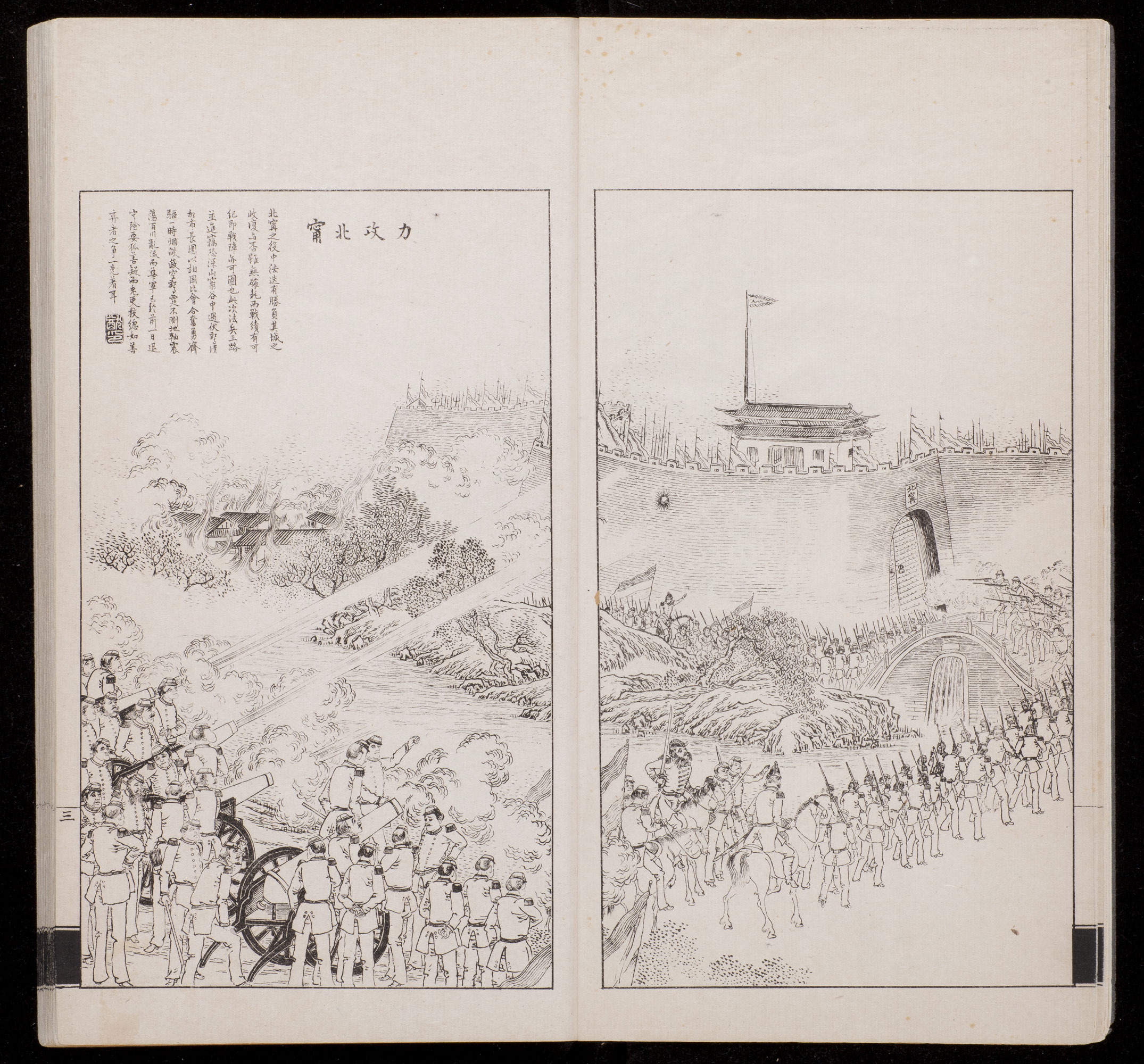 |
Title: “The Forceful Attack on Beining” [Bac Ninh in Vietnam] 力攻北寧 Volume: 1 Issue: 1 Page Number: 3 Caption Translation: During the battle of Bacninh, both the Chinese and the French had repeated successes and failures. Though there is no exact news regarding whether or not the city has been recovered, we have heard of military successes, and we can illustrate the disposition of the troops. The French army advanced along three routes, and fearing that they would encounter ambushes in the deep mountains and remote valleys, they spread out and encircled their enemy. When the three divisions met, they stormed the city with great enthusiasm. Soon smoke and flame covered the sky, thundering cannon fired from all sides, the earth shook and swayed, and the rivers flowed turbulently. The Chinese army, however had already withdrawn on the previous day to stand their ground in a strategic position. As the proverb says, "the fox is suspicious, yet the hare is even more cunning; the great go experts always plan one step ahead." Translator: Wang Guojun, revised by Peter C. Perdue |
Caption Text: 北寧之役, 中法迭有勝負, 其城之收復與否, 雖無確耗, 而戰績有可紀, 即戰陣亦可圖也。此次法兵三路並進, 竊恐深山窮谷中遇伏驚潰, 故布長圍以相困。比會合, 奮勇齊驅。一時煙焰蔽空, 驚霆不測, 地軸震盪, 百川亂流, 而華軍已於前一日退守險要。狐善疑, 而兔更狡, 總如善弈者之爭一先着耳 Comments: The Sino-French war over Annam (northern Vietnam) began in 1883, after Annam agreed to become a French protectorate, while still sending tribute to China. It ended with a peace treaty in 1885, in which China yielded all claims to influence in Annam. The French attack on Bac Ninh, a town on the Annam border, began in March, 1884, and ended several months later with a complete defeat of Qing forces, and French occupation of the Red River delta. This report was published on May 8, 1884, at a time when the outcome of the battle was uncertain, or the journalists were concealing unwelcome news from their readers. The picture shows a Chinese flag still flying from the fort as the French troops storm it. View on Yale Visual Resources |
 |
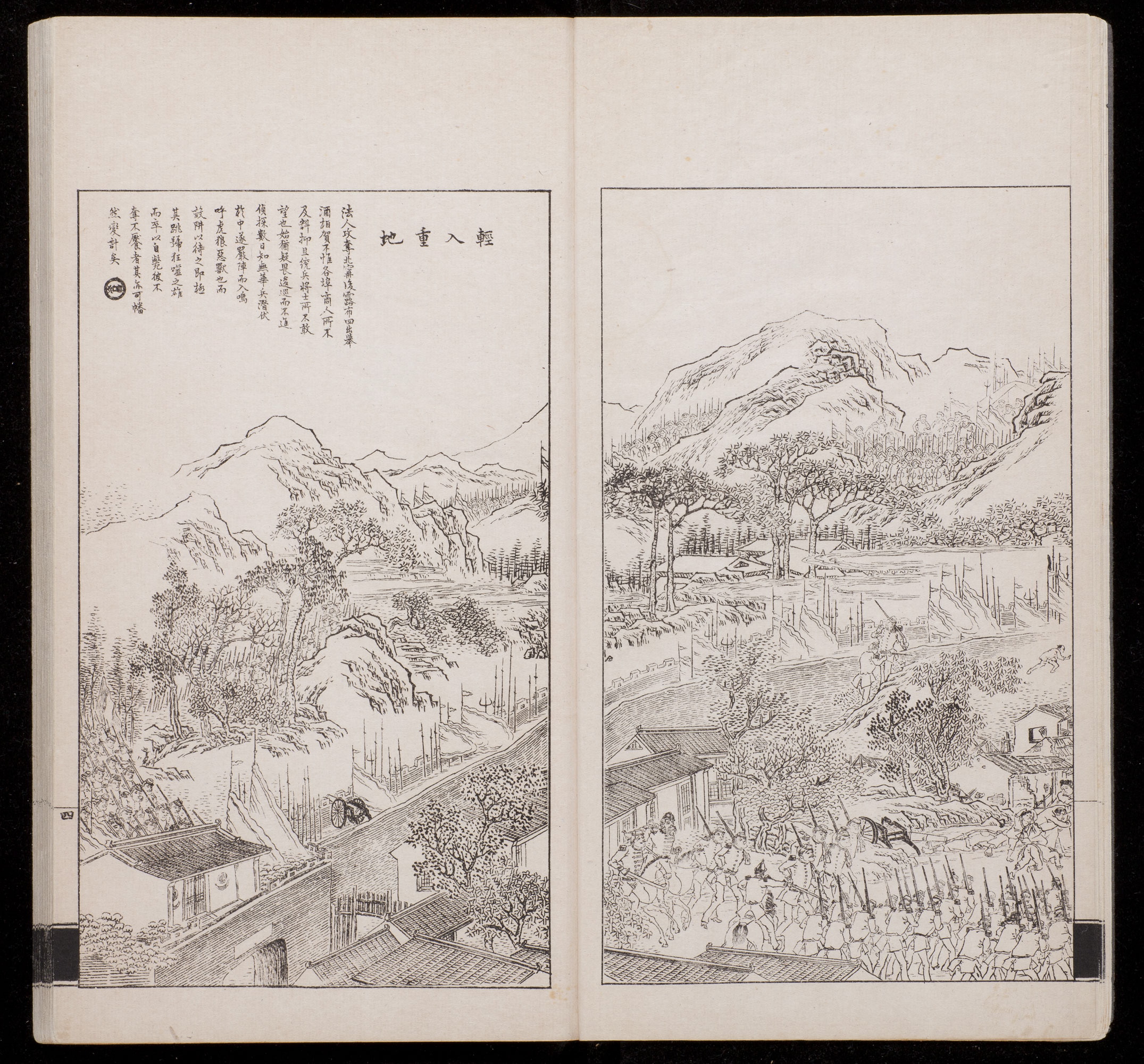 |
Title: “Easily Capturing a Strategic Place” 輕入重地 Volume: 1 Issue: 1 Page Number: 4 Caption Translation: After the French had attacked and seized Bac Ninh, they sent messages reporting victory in all directions, and they drank wine to congratulate each other. Not only was it beyond the expectations of merchants at each port, but it also exceeded the expectations of the generals in charge of the army. Initially the suspicious generals hesitated to advance, spying out the position for several days. When they knew that there were no Chinese troops hidden in ambush, they formed an ordered battle array and entered the city. Alas! The tiger and the wolf are evil beasts, but people use traps and wait for them. Even though they are ferocious animals that hide in the woods, leap out and bite, in the end they cause their own deaths. As Mencius said of those who insatiably pursue advantage, they can be trapped by a sudden change of plans. |
Translator: Wang Guojun, revised by Peter C. Perdue Caption Text: 法人攻奪北寧後, 露布四出, 舉酒相賀, 不惟各埠商人所不及料, 抑且統兵將士所不敢望也。始猶疑畏, 逡巡而不進, 偵探數日, 知無華兵潛伏於中, 遂嚴陣而入。嗚呼, 虎狼惡獸也, 而蔽阱以待之, 即極其跳骚狂噬之雄, 而卒以自斃。彼不奪不饜者, 其亦可幡然變計矣。 Comments: The last sentence alludes to the first passage in Mencius: "those who put righteousness last and profit first, will never be satisfied until they have grabbed everything." View on Yale Visual Resources |
 |
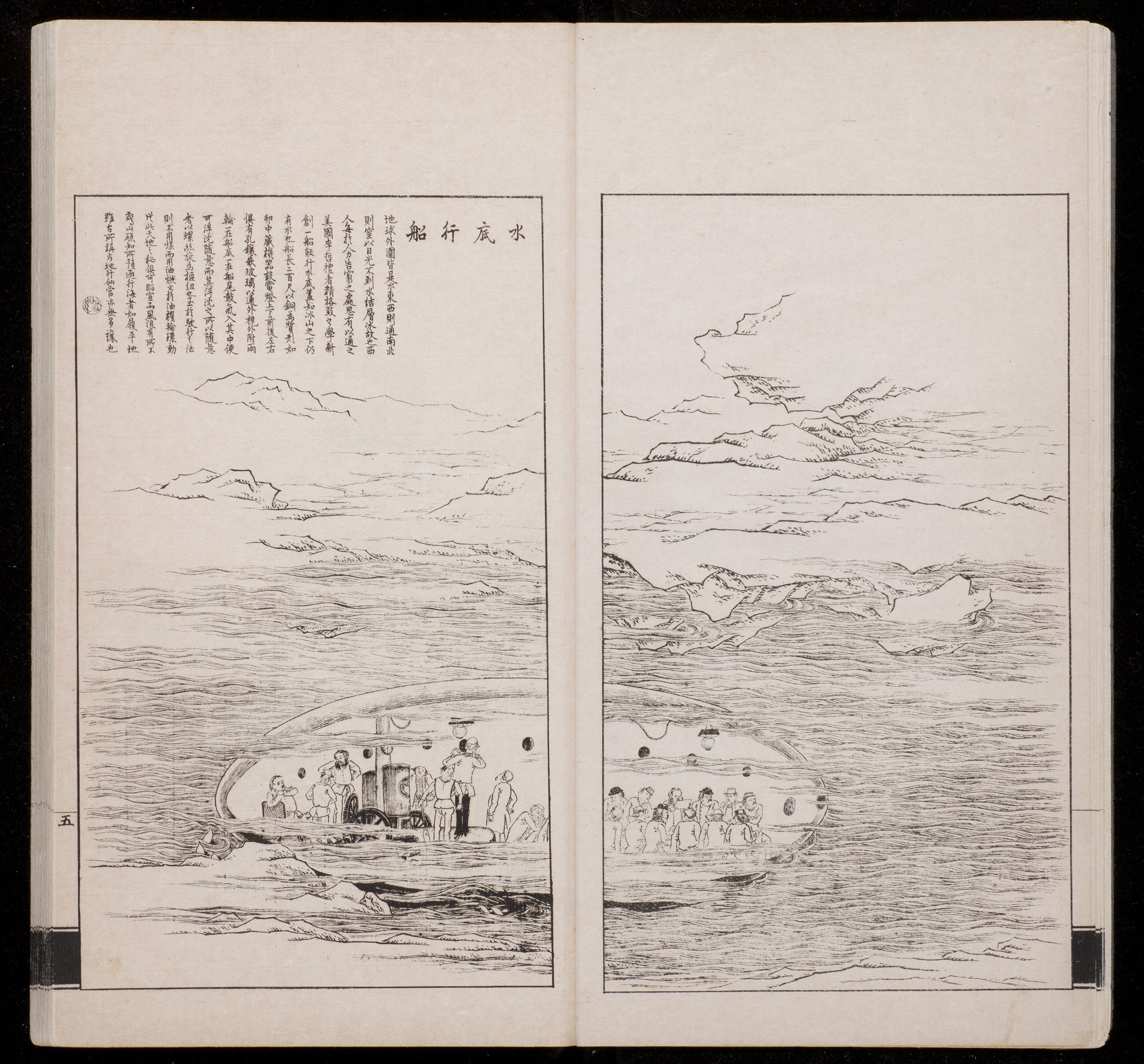 |
Title: “A Submarine” 水底行船 Volume: 1 Issue: 1 Page Number: 5 Caption Translation: The surface of the earth is covered with water. One can travel on it continuously from east to west, but to the north and south there are obstructions, because the lack of sunlight causes the water to freeze into layers of ice. Westerners know how to overcome obstacles to human efforts. The American Li Zheli [Richell? Richards?] who has an advanced understanding of science, has recently devised a ship capable of traveling underwater, knowing that underneath the icebergs there remains liquid water. The ship is two hundred feet long, and is constructed using copper, in the shape of an egg. It has an engine inside, and are electric lights; on all sides are portals inlaid with glass through which to look outside. On the outside two wheels are attached, one on the underside of the ship, the other at the stern. Compressed air enters into the center, making it possible to submerge and rise as one pleases; the reason this can happen is because a screw spins at the core of the ship. For propulsion, it does not use coal but uses petroleum, and the burning of the petroleum causes the machine’s wheels to rotate. Now the mysteries of heaven and earth can all can be clearly revealed. |
People will no longer be startled by the wind or waves, and they can avoid underwater rocks and reefs. People will cruise the seas as if walking on flat land. They will surpass the fairy immortals of old. Translator: Wang Guojun, revised by Peter C. Perdue Caption Text: 地球外圍皆是水, 東西則通, 南北則窒, 以日光不到, 水結層冰故也。西人每於人力告窮之處, 思有以通之。美國李哲禮者, 精格致之學, 新創一船, 能行水底。蓋知冰山之下, 仍有水也。船長二百尺, 以銅為質, 形如卵;中藏機器, 設電燈; 上下前後左右俱有孔, 鑲嵌玻璃以通外視;外附兩輪, 一在船底, 一在船尾。鼓氣入其中, 便可浮沉隨意; 而其浮沉之所以隨意者, 以螺絲旋為樞紐也。至於駛行之法, 則不用煤而用油, 燃火於油, 機輪環動。從此天地之秘, 俱可昭宣, 而風浪有所不驚, 山礁知所預避, 行海者如履平地。雖古所稱為地行仙, 當亦無多讓也。 Comments: The source of information given here is unclear. The first underwater boat was invented in 1776 by David Bushnell. There is no record of an engineer with the name "Richards" or "Richell", and no specific record of such a submarine, but 1883 was the International Year of Exploration, so the information may have come from descriptions of activities in this year. View on Yale Visual Resources |
 |
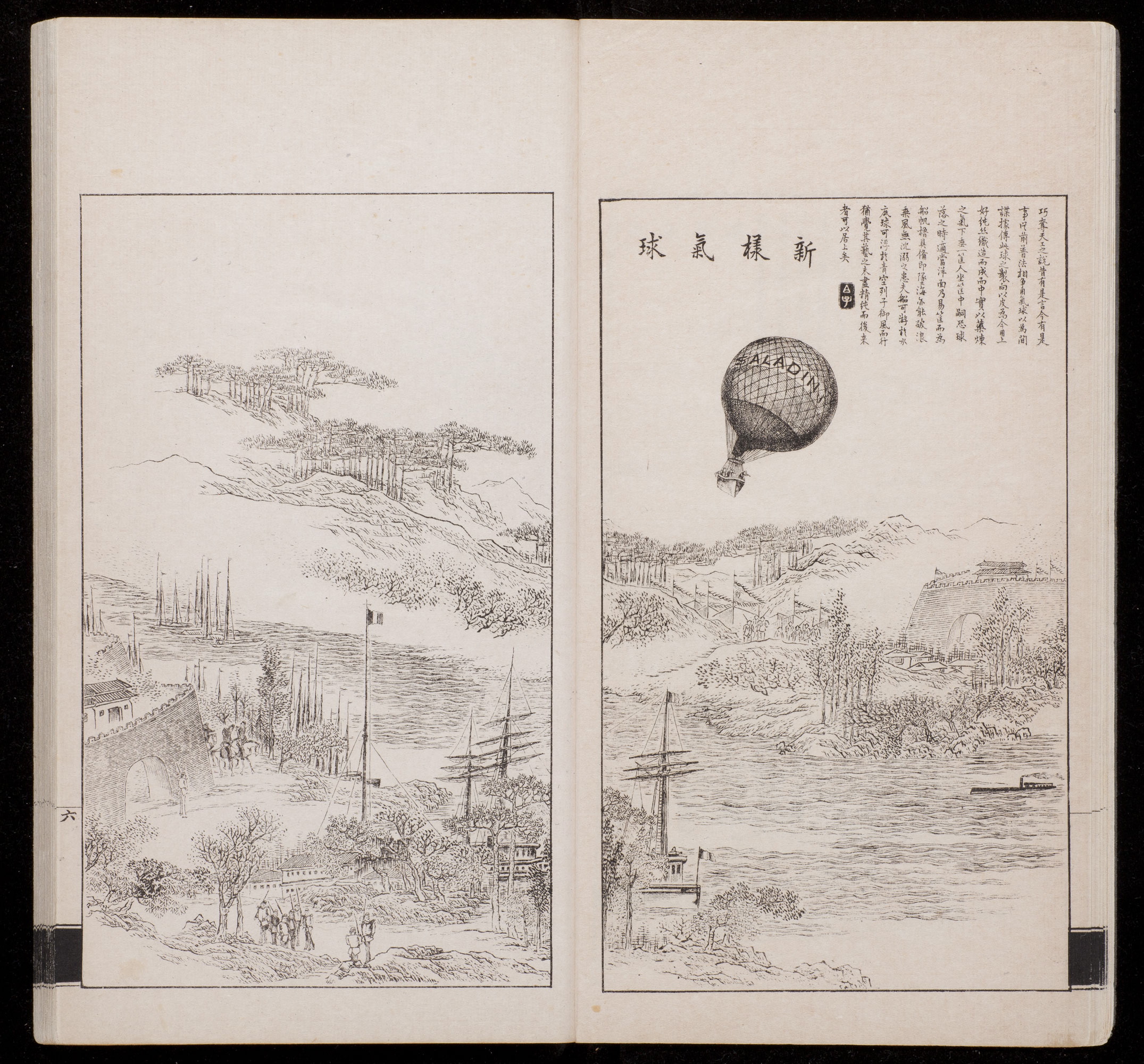 |
Title: “A New Type of Gas Balloon” 新樣氣球 Volume: 1 Issue: 1 Page Number: 6 Caption Translation: In the past people only told tales of wonderful workmanship; now we have the real thing. Formerly, when France and Prussia went to war [1870], they used gas balloons for spying. We understand that these balloons were made out of leather. Now, they are made out of pure silk. The interior is filled with chemical gas, and underneath hangs a basket in which people sit. Later, fearing that the balloon might accidentally fall into the sea, they replaced the basket with a boat, rigging it with sails and oars. Now even if it falls into the sea, the balloon can ride the waves and sail the seas without any fear of sinking. Now we have boats that can travel under the water, and balloons that can float in the blue sky. Even though the ancient sage Liezi could ride on the wind, we feel that his skills were not yet completely refined. Those who come later can surpass him. |
Translator: Wang Guojun, revised by Peter C. Perdue Caption Text: 巧奪天工之說, 昔有是言, 今有是事。 從前普法相爭, 用氣球以為間諜。 據傳此球之製向以皮為, 今用上好純絲織造而成, 而中實以藥煉之氣, 下垂一筐, 人坐筐中。 嗣恐球落之時, 適當洋面, 乃易筐而為船, 帆櫓具備, 即墜海亦能破浪乘風, 無沈溺之患。 夫船可游於水底, 球可浮於青空, 列子御風而行, 猶覺其藝之未盡精純, 而後來者可以居上矣。 View on Yale Visual Resources |
 |
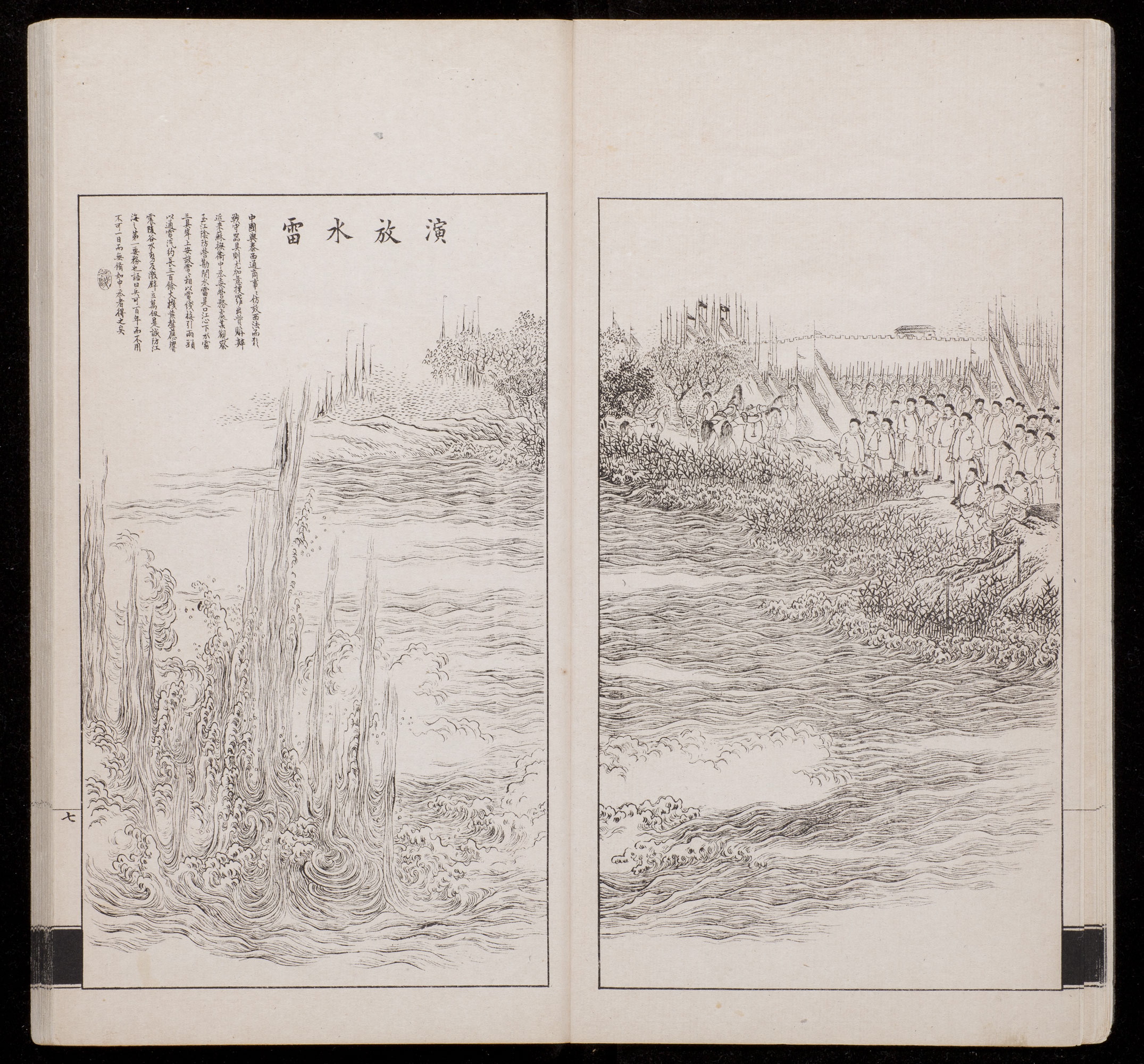 |
Title: “Setting Out Underwater Mines” 演放水雷 Volume: 1 Issue: 1 Page Number: 7 Caption Translation: In commercial relations between China and the West, everyone imitates Western methods. When it concerns military defense, we take special care to find and purchase the best equipment. The recently arrived Suzhou Provincial Governor Vice Censor Wei, who was charge of military affairs, when he inspected Jiangyin’s defensive encampment, examined the underwater mines. In the river right under the port were three submarine mines. On the shore an electric box was installed, and wires connected it to the mines, over a distance of more than three hundred zhang [about 1/2 mile]. Setting off the trigger produced a blast that caused the hills and valleys to quake, and the river water surged backward for ten thousand fathoms. This truly is the most effective way to guard the coast. We say that "even if an army may not be used once in a hundred years, one cannot for a single day be unprepared. " Vice Censor Wei grasps this principle. |
Translator: Paul Vierthaler, revised by Peter C. Perdue Caption Text: 中國與泰西通商, 事事仿效西法, 而於戰守器具則尤加意搜羅, 出貲購辦。 近來蘇撫衛中丞委營務處某觀察至江陰防營勘閱水雷, 是口江心下水雷三具, 岸上安設電箱, 以電綫接引兩頭, 以通電汽, 約長三百餘丈, 機發聲應, 響震陵谷, 水勢反激, 辟立萬仞, 是誠防江海之第一要務也。 語曰:兵可百年而不用, 不可一日而無備。 如中丞者得之矣。 View on Yale Visual Resources |
 |
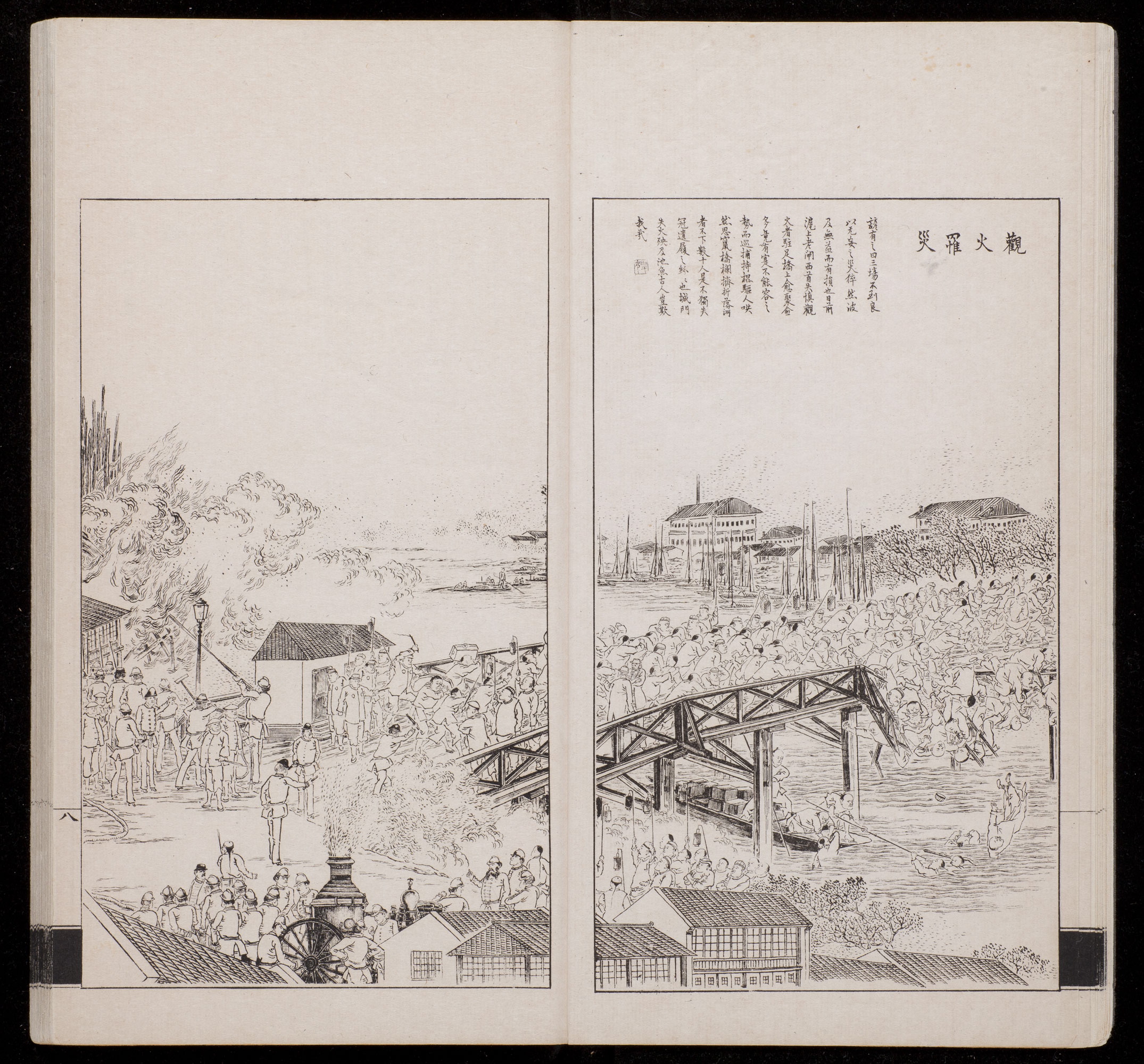 |
Title: “Disaster Strikes Spectators at a Fire” 觀火罹災 Volume: 1 Issue: 1 Page Number: 8 Caption Translation: There is a proverb that says [good men] should not go to the theatre, or to the examination halls [because riots occur there]. Accidental calamity can suddenly spread, and there will be losses with no profit. The other day at the old sluice gate on Shanghai’s West road because of carelessness [there was a fire], so a large crowd of people halted on top of a bridge to view it, more than the bridge could hold. The police on patrol used sticks to drive the crowd forward, the boisterous crowd tried to escape, and the bridge’s balustrade was broken by the crowd squeezing against it. Dozens of people fell in the river. This is not just a trivial case of people losing their hats and shoes! Truly the ancient story was correct: when the city gate caught on fire, so many people went to the moat to fetch water that the fish all died. |
Translator: Paul Vierthaler, revised by Peter C. Perdue Caption Text: 諺有之曰:三塲不到, 良以无妄之災猝然波及, 無益而有損也。 日前滬上老閘西首失慎, 觀火者駐足橋上愈聚愈多, 竟有寔不能容之勢。 而巡捕持棍驅人, 哄然思竄, 橋欄擠折, 落河者不下數十人。 是不獨失冠遺履之紛紛也。 城門失火, 殃及池魚。 古人豈欺我哉 View on Yale Visual Resources |
 |
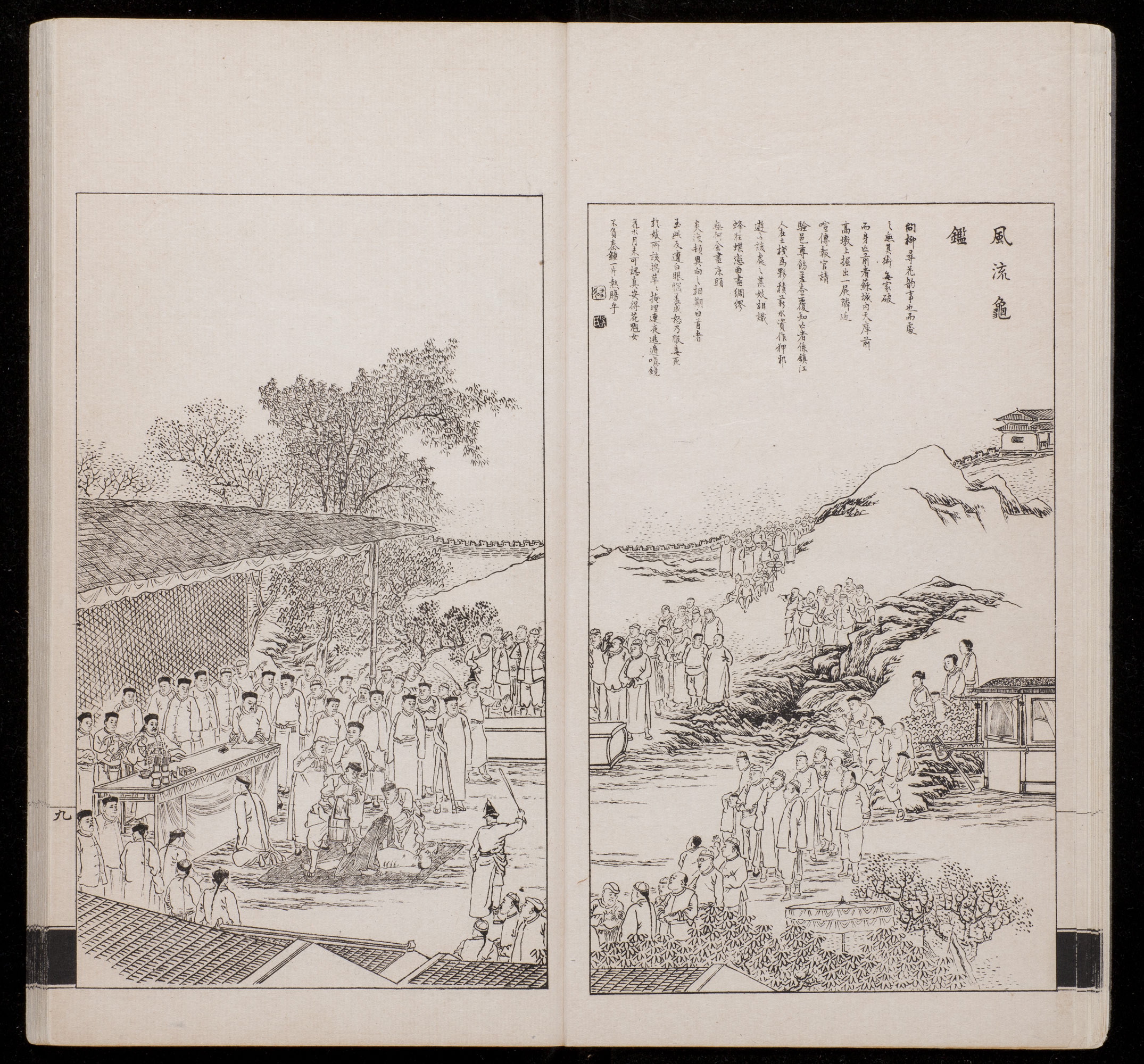 |
Title: “The Sophisticated Turtle Mirror” 力攻北寧 Volume: 1 Issue: 1 Page Number: 9 Caption Translation: Visiting brothels [lit. asking of the willow, seeking the flowers] can be very diverting, however, unskilled patrons can ruin themselves and their family. Some time ago, in Suzhou a corpse was dug out from the tall mound in front of the former imperial storehouse. People in the neighborhood spread the news, reported it to local officials, and asked for an investigation. The county magistrate ordered runners to investigate, and they learned that the deceased came from Zhenjiang. Working as a servant at the local inn, he saved his salary and roamed the brothel alleys. He became acquainted with a certain prostitute there. Like crazed bees and passionate butterflies, they fell head over heels in love. Shortly thereafter, when the man ran out of money, the prostitute turned cold toward him. Before, they expected to stay together until they had white hair, now instead he met with disapproval. Shamed into anger, he poisoned himself and died in the prostitutes’ quarter. The madam hurriedly buried him and fled the same night. In short, the flowers in the mirror, the moon reflected in water cannot be taken for reality. How could the beautiful girl Hua Kui not surpass Qin Zhong’s warm-heartedness! |
Translator: Paul Vierthaler, revised by Peter C. Perdue Caption Text: 前者蘇城內天庫前高墩上掘出一屍, 鄰近喧傳, 報官請驗, 邑尊飭差查覈, 知亡者係鎮江人, 在土棧為夥, 積薪水資, 作狎邪遊, 与該處之某妓相識, 蜂狂蝶戀, 曲盡綢繆。 無何, 金盡床頭, 炎涼頓異。 向之相期白首者, 至此反遭白眼, 惱羞成怒, 乃服毒死於妓所。 該鸨草草掩埋, 連夜逃遁噫, 鏡花水月, 未可認真, 安得花魁女不負秦鍾片熱腸乎! Comments: The last line refers to Hua Kui, a famous courtesan from the short story "The Oil Seller" by Feng Menglong, and Qin Zhong, a beautiful young man in the novel Hong Loumeng, rumored to have intimate relations with the hero, Bao Yu. View on Yale Visual Resources |
 |
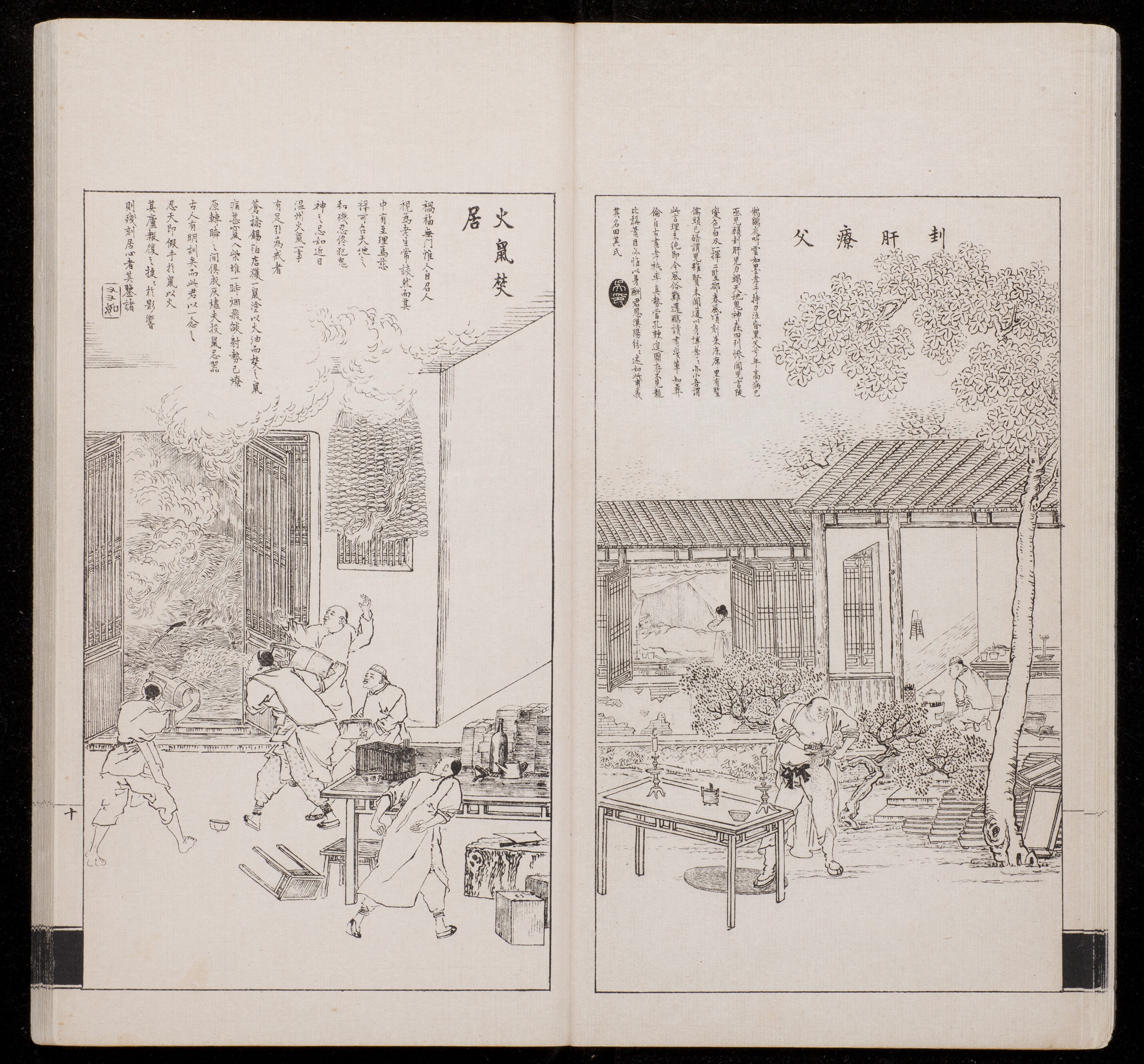 |
Title: “Cutting Out his Own Liver to Cure his Father” 刲肝療父 Volume: 1 Issue: 1 Page Number: 10 Caption Translation: The owl cries at night amid the inky clouds, the filial son carrying a knife sobs in the dusk. The eldery father, advanced in years, was close to death; the son was willing to cut out his liver to give him his strength. The spirits of Heaven and earth surrounded him like a forest; grieving, they heard the son’s words, and suddenly changed countenance. The white knife in one cut cured the father and son, both stood up, and spring breezes instantly blew across the bed. An elderly upright scholar in the neighborhood told the son, "despite your dedication you are not yet enlightened. You used your body to express filial piety, but your devotion was slight." I call this man's reasoning highly deficient. Since these days it is very difficult to purify people’s behavior. can studying for several generations lead to understanding the theory of morality and ethics? Since ancient times fulfilling filial duties has shown the utmost respect; in such trying times we all just want to survive. Not seeing the dragon is like covering the eyes, as is only using your body to repay the kindness of your lord.[?] Many people in Hanyang spread the story of this man, whose name is Tian Fuyi. |
Translator: Paul Vierthaler, revised by Peter C. Perdue Caption Text: 孝子持刀泣昏黑。 父号年高病已亟, 兒願刲肝兒力竭。 天地鬼神森四列, 慘聞兒言陡變色。 白刃一揮二竪郤, 春風頃刻來床席。 里有竪儒頭巳皓, 謂兒雖賢未聞道。 以身博孝孝亦小, 吾謂此言理未純, 即今風俗難還醇, 讀書幾輩知彜倫。 自古盡孝衹率真, 勢當孔棘遑圖存。 不見龍比稱蓋目, 亦惟以身酬君恩, 漢陽紛紛述如此甫義其名田其氏。 View on Yale Visual Resources |
Title: “A Mouse on Fire Sets a Residence Ablaze” 火鼠焚居 Volume: 1 Issue: 1 Page Number: 10 Caption Translation: The old saw makes a lot of sense: "No one can predict fortune, but people bring disaster on themselves." Gentle people enjoy the harmony of heaven and earth, but cruel people who violate the taboos get what they deserve. The recent incident of the “mouse on fire” in Wenzhou can serve as a warning. At the Blue Bridge tinfoil paper shop, they caught a mouse, spread lard on it and lit it on fire. The mouse in agony fled into a pile of firewood. In a minute smoke and flames shot out, burning like a prairie fire. In the blink of an eye the whole shop had burned to ashes. The sages clearly instructed: "Don't throw stones at the rat that hides among the sacrifical vessels." Heaven took the opportunity to punish this cruel man.It used the mouse to burn down his house, as revenge for this, to combat his evil influence. This is a warning to all of those who harbor evil intentions. Translator: Paul Vierthaler, revised by Peter C. Perdue |
Caption Text: 禍福無門, 惟人自召, 人視為老生常談, 然而其中有至理焉。慈祥可召天地之和, 殘忍終犯鬼神之忌, 如近日溫州火鼠一事, 有足引為戒者。蒼橋錫箔店獲一鼠, 塗以大油而焚之, 鼠痛甚竄入柴堆, 一時烟飛燄射, 勢已燎原, 轉瞬之間俱成灰燼。夫投鼠忌器, 古人有眀訓矣。而此君以一念之忍, 天即假手於鼠以火其盧報復之捷之於影響, 則殘刻居心者其鑒諸 View on Yale Visual Resources |
| Preface (page 1) 1884 [dz_v01_003] |
Preface (page 2) 1884 [dz_v01_04] |
“The Forceful Attack on Beining” [Bac Ninh in Vietnam] 力攻北寧 (page 3) 1884 [dz_v01_005] |
“Easily Capturing a Strategic Place” 輕入重地 (page 4) 1884 [dz_v01_006] |
“A Submarine” 水底行船 (page 5) 1884 [dz_v01_007] |
“A New Type of Gas Balloon”
新樣氣球 (page 6) 1884 [dz_v01_008] |
“Setting Out Underwater Mines” 演放水雷 (page 7) 1884 [dz_v01_009] |
“Disaster Strikes Spectators at a Fire” 觀火罹災 (page 8) 1884 [dz_v01_010] |
“The Sophisticated Turtle Mirror” 力攻北寧 (page 9) 1884 [dz_v01_011] |
“Cutting Out his Own Liver to Cure his Father”
刲肝療父 (page 10), “A Mouse on Fire Sets a Residence Ablaze” 火鼠焚居 (page 10) 1884 [dz_v01_012] |
